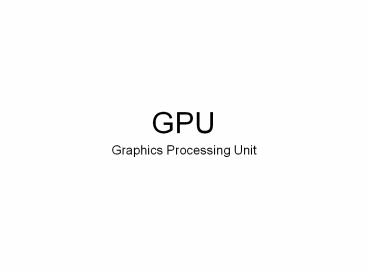GPU PowerPoint PPT Presentation
Title: GPU
1
GPU
- Graphics Processing Unit
2
Graphics Pipeline
Scene Transformations
Lighting Shading
Viewing Transformations
GPUs evolved as hardware and software algorithms
evolve
Rasterization
3
Early Graphics
- Originally, no specialized graphics hardware
- All processing in software on CPU,
- Results transmitted to frame buffer
- first, external frame buffers
- later, internal frame buffers.
CPU
Frame buffer
Display
4
More detailed pipeline
Simple functionality transferred to specialized
hardware.
5
Add more functionality to GPU.
Simple functionality transferred to specialized
hardware
6
Fixed function GPU pipeline
- Pipeline implemented in hardware
- Each stage does fixed task
- Tasks are parameterized
- Inflexible fixed, parameterized functions
- Vector-matrix operations (some parallelism).
GPU
CPU
Display
Frame buffer
7
Technology advances
- Hardware gets cheaper, smaller, and more powerful
- Parallel architectures develop
- Graphics processing get more sophisticated
(environmental mapping, displacement mapping,
sub-surface scattering) - Need more flexibility in GPUs.
8
Make this programmableVertex Shader
Make this programmable Fragment Shader
9
Vertex shader
- Graphics systems convert everything to triangles
- Pass vertices, normals, colors, texture
coordinates to GPU processor - GPU vertex-based computations,
- Independent of other vertices
- Later, assemble into triangles.
10
Fragment shader
- Fragment is triangle clipped to pixel
- Interpolate values
- Multiple textures, Alpha, stencil, depth
- Independent of other fragments
- Blend with contents of frame buffer.
11
Geometry data
Vertex Shader
Culling, perspective divide, viewport mapping
Introduce parallelism add multiple units
Rasterization
Fragment Shader
Alpha test, depth test, stencil test
Frame buffer blending
12
Shading language
- Shade trees -gt Pixars Renderman shader
13
Shader Language
- Low level (like assembler) but high-level
language compilers nVidias Cg - 4 component floating point data type
- SIMD
14
Cg C-based graphics program
- Array structures
- Flow control
- Vectors matrices
- No memory allocation, file I/O
15
Power
- GPUs have moved away from the traditional
fixed-function 3D graphics pipeline toward a
flexible general-purpose computational engine. - The raw computational power of a GPU dwarfs that
of the most powerful CPU, and the gap is steadily
widening. - GPUs have moved away from the traditional
fixed-function 3D graphics pipeline toward a
flexible general-purpose computational engine
16
Next unify shaders
- One set of shaders
- Allocate to either vertices or fragments
17
Pipeline evolved
18
Evolved pipeline
19
GPGPU
- Make GPU more general adapt certain types of
programs to its pipelined, parallel architecture - Single GeForce 8800 chip achieves a sustained
330 billion floating-point operations per second
(Gflops) on simple benchmarks - Cost-effective graphics driving demand up,
supply up, price down for GPUs - Finding uses in non-graphics applications.
20
GeForce 8800 GTX
21
More general NVIDIAs CUDA
- More general data parallel model
- Decompose across threads
- Sharing and communication between threads..

